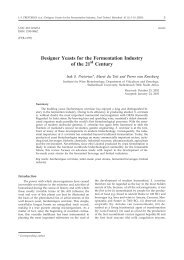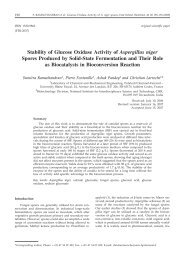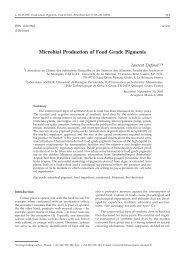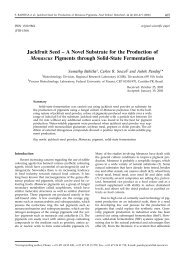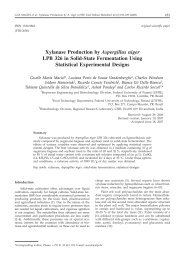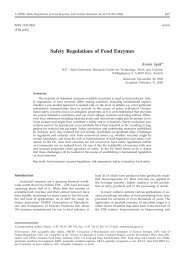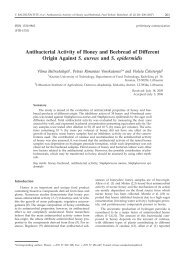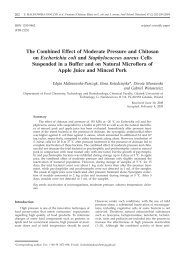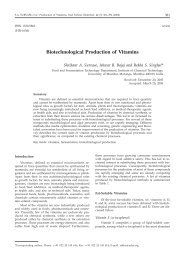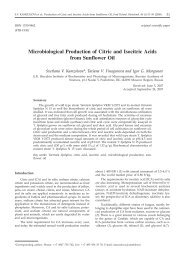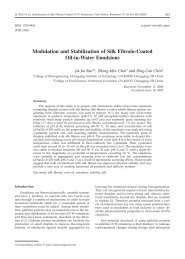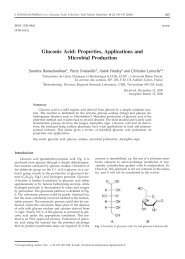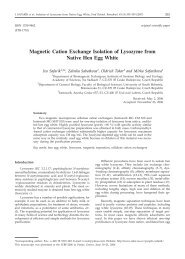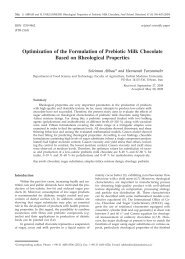Non-Aqueous Biocatalysis in Heterogeneous Solvent Systems
Non-Aqueous Biocatalysis in Heterogeneous Solvent Systems
Non-Aqueous Biocatalysis in Heterogeneous Solvent Systems
Create successful ePaper yourself
Turn your PDF publications into a flip-book with our unique Google optimized e-Paper software.
N. KRIEGER et al.: <strong>Non</strong>-<strong>Aqueous</strong> <strong>Biocatalysis</strong> <strong>in</strong> <strong>Heterogeneous</strong> <strong>Solvent</strong> <strong>Systems</strong>, Food Technol. Biotechnol. 42 (4) 279–286 (2004)<br />
UDC 577.128.15 m<strong>in</strong>i review<br />
ISSN 1330-9862<br />
(FTB-1448)<br />
<strong>Non</strong>-<strong>Aqueous</strong> <strong>Biocatalysis</strong> <strong>in</strong> <strong>Heterogeneous</strong> <strong>Solvent</strong> <strong>Systems</strong><br />
Introduction<br />
Nadia Krieger 1 *, Tej Bhatnagar 2 , Jacques C. Baratti 2 , Alessandra M. Baron 1 ,<br />
Valéria M. de Lima 1 and David Mitchell 3<br />
1 <strong>Biocatalysis</strong> and Enzyme Technology Laboratory, Applied Chemistry Research Centre (CEPESQ),<br />
Chemistry Department, Federal University of Parana (UFPR), PO Box 19081, Centro Politécnico,<br />
Jardim das Américas, Curitiba 81531-990, Paraná, Brazil<br />
2 <strong>Biocatalysis</strong> and F<strong>in</strong>e Chemistry Group, Université de la Mediterranée,<br />
Faculté des Sciences de Lum<strong>in</strong>y, CNRS ERS, 157, Marseille, France<br />
3 Fermentation and Enzyme Technology Laboratory, Biochemistry and Molecular Biology Department,<br />
PO Box 19046, Centro Politécnico, Jardim das Américas, Curitiba 81531-990, Paraná, Brazil<br />
Received: September 15, 2004<br />
Revised version: October 20, 2004<br />
Accepted: November 22, 2004<br />
Summary<br />
<strong>Biocatalysis</strong> has become a useful alternative to chemical transformations for the production<br />
of a range of compounds with applications <strong>in</strong> the food, feed, chemical and pharmaceutical<br />
<strong>in</strong>dustries. However, it is not necessarily an easy task to obta<strong>in</strong> the desired levels<br />
of performance <strong>in</strong> terms of rate, yield and selectivity of the reaction. One strategy for<br />
optimiz<strong>in</strong>g biocatalyst performance is to use non-conventional media, such as non-aqueous<br />
heterogeneous systems. In this article, we highlight some of the current trends <strong>in</strong><br />
biocatalysis <strong>in</strong> such systems, focus<strong>in</strong>g on reverse micelles, supercritical fluids and ionic liquids.<br />
Key words: biocatalysis, non-conventional media, reverse micelles, supercritical fluids, ionic<br />
liquids<br />
In biocatalysis, the term non-conventional media refers<br />
to systems that use solvents other than water or the<br />
addition of components to aqueous systems with the <strong>in</strong>tention<br />
of favor<strong>in</strong>g specific properties of the biocatalyst<br />
or the reaction catalyzed by it. <strong>Non</strong>-conventional media<br />
can be used for biocatalysis with either enzymes or<br />
whole cells.<br />
The solvent can cause modifications <strong>in</strong> the conformation<br />
of the enzyme, alter<strong>in</strong>g either its catalytic efficiency<br />
or specificity. For example, through the rational<br />
use of non-conventional media, it may be possible to <strong>in</strong>crease<br />
the enantioselectivity of the reaction catalyzed by<br />
279<br />
the biocatalyst. <strong>Non</strong>-aqueous reaction media may also<br />
<strong>in</strong>crease the stability of the enzyme (1–3). A further advantage<br />
is that the risk of microbial contam<strong>in</strong>ation is<br />
lower than is the case <strong>in</strong> aqueous systems. <strong>Non</strong>-conventional<br />
media are of special <strong>in</strong>terest for hydrolases s<strong>in</strong>ce<br />
low water contents can be used <strong>in</strong> order to favor synthesis<br />
reactions and, <strong>in</strong> the case of lipases, to provide better<br />
solubility of hydrophobic substrates.<br />
The water-restricted organic systems used <strong>in</strong> biocatalysis<br />
can be classified as heterogeneous and homogeneous.<br />
Homogeneous systems are reviewed by Torres<br />
and Castro (4). <strong>Heterogeneous</strong> systems <strong>in</strong>clude liquid-<br />
-liquid macro-heterogeneous systems, <strong>in</strong> which water<br />
represents 1 to 5%ofthereaction medium, liquid-solid<br />
* Correspond<strong>in</strong>g author; Phone: ++55 41 36 13 470; Fax: ++55 41 36 13 186; E-mail: nkrieger@ufpr.br
280 N. KRIEGER et al.: <strong>Non</strong>-<strong>Aqueous</strong> <strong>Biocatalysis</strong> <strong>in</strong> <strong>Heterogeneous</strong> <strong>Solvent</strong> <strong>Systems</strong>, Food Technol. Biotechnol. 42 (4) 279–286 (2004)<br />
macro-heterogeneous systems and micro-heterogeneous<br />
systems. This m<strong>in</strong>i-review highlights some of the recent<br />
developments <strong>in</strong> the use of heterogeneous non-conventional<br />
media for biocatalysis, such as reverse micelles,<br />
supercritical fluids and ionic liquids.<br />
General Considerations about <strong>Biocatalysis</strong> <strong>in</strong><br />
<strong>Non</strong>-Conventional <strong>Heterogeneous</strong> Media<br />
In macro-heterogeneous systems there is a visible<br />
separation of phases, such as systems that use immobilized<br />
enzymes or powdered enzymes. In micro-heterogeneous<br />
systems the separation of phases can only be<br />
observed microscopically, such as is the case with reverse<br />
micelles. In reverse micelles, the amount of water<br />
<strong>in</strong> the system is generally expressed <strong>in</strong> terms of the parameter<br />
W0 (H2O/surfactant), while <strong>in</strong> other systems<br />
it is expressed <strong>in</strong> terms of the water activity (aw)(5–8). In the case of reactions catalyzed by hydrolases, the<br />
amount of water can be manipulated to favor either<br />
synthesis or hydrolysis reactions. In the reversed micellar<br />
system it also affects the size of the micelles and the<br />
conformation of the enzyme with<strong>in</strong> the micelles.<br />
Unfortunately, despite the advantages that biocatalysis<br />
<strong>in</strong> organic solvent-based systems can br<strong>in</strong>g, the<br />
catalytic activities of enzymes <strong>in</strong> these systems are typically<br />
much lower than activities <strong>in</strong> aqueous solutions<br />
(9). Further, prote<strong>in</strong> stability is lower <strong>in</strong> water-miscible<br />
solvents (–2.5
N. KRIEGER et al.: <strong>Non</strong>-<strong>Aqueous</strong> <strong>Biocatalysis</strong> <strong>in</strong> <strong>Heterogeneous</strong> <strong>Solvent</strong> <strong>Systems</strong>, Food Technol. Biotechnol. 42 (4) 279–286 (2004)<br />
Table 1. Recent examples of reactions catalyzed by enzymes <strong>in</strong> reversed micellar systems<br />
Source (Enzyme) Surfactant Organic solvent Reaction Reference<br />
Thermomyces lanug<strong>in</strong>osa (lipase) AOT Isooctane Synthesis of ethyl-laurate 25<br />
-chymotryps<strong>in</strong> AOT n-heptane Hydrolysis of 2-naphthyl acetate 26<br />
Bacillus megaterium (lipase) AOT n-heptane Hydrolysis of pNPP 15<br />
Rhizopus delemar (lipase) AOT Isooctane Hydrolysis of triole<strong>in</strong> 27<br />
Mucor javanicus (lipase) AOT Isooctane Acylation of doxorubic<strong>in</strong> 28<br />
Horse heart (Microperoxidase-11) AOT Isooctane Oxidative decolorization of azo and anthraqu<strong>in</strong>one dyes 29<br />
Candida lypolytica (lipase) AOT Isooctane Esterification of octanoic acid with 1-octanol 30<br />
Key: AOT (sodium bis-2-ethylhexyl sulfosucc<strong>in</strong>ate), pNPP (p-nitrophenylpalmitate)<br />
tions often <strong>in</strong>volve hydrophobic substrates, which are<br />
readily soluble <strong>in</strong> the bulk organic phase. Further, some<br />
enzymes are highly stable <strong>in</strong> reverse micelles, such as<br />
-chymotryps<strong>in</strong> and the lipase of Chromobacterium viscosum<br />
(23).<br />
Due to the complexity of the reversed micelle system,<br />
with the addition of different enzymes, buffers,<br />
salts, substrates and products <strong>in</strong>fluenc<strong>in</strong>g the size and<br />
shape of the micelles formed, it is difficult to make predictions<br />
as to how the system will perform <strong>in</strong> a specific<br />
case. The selection of the reversed micelle system is typically<br />
based on the successes reported <strong>in</strong> the literature<br />
for similar enzymes and reactions (23,24). Table 1 reports<br />
some such reactions, with potential applications <strong>in</strong><br />
the food, pharmaceutical and chemical <strong>in</strong>dustries and<br />
also <strong>in</strong> the environmental area (15,25–30).<br />
The results reported for reversed micellar systems<br />
for the synthesis of esters with applications <strong>in</strong> the food<br />
sector, such as ester-based aromas, are better, <strong>in</strong> terms<br />
of overall conversion and reaction rate, than those reported<br />
for other water-restricted media. For <strong>in</strong>stance, for<br />
ethyl-laurate synthesis by Thermomyces lanug<strong>in</strong>osa lipase,<br />
a yield of 90 % was obta<strong>in</strong>ed after 60 m<strong>in</strong> <strong>in</strong> an AOT-<br />
-isooctane reversed micellar system (25), whereas 168 h<br />
was required for a 95 % yield of ethyl-caproate when<br />
lyophilized powder of the esterase of Bacillus licheniformis<br />
was added directly to n-heptane (31) and 72 h was<br />
required for a 95 % yield of isoamyl acetate us<strong>in</strong>g an immobilized<br />
lipase of Rhizopus miehei <strong>in</strong> isooctane (32).<br />
Before reversed micellar systems can be effectively<br />
applied at <strong>in</strong>dustrial scale, there are some issues to be<br />
solved. It is difficult to recover the product from reverse<br />
micelles at large scale due to the presence of the surfactant<br />
and other components of the system, such as prote<strong>in</strong><br />
and water. A possible solution is cont<strong>in</strong>uous operation<br />
<strong>in</strong> membrane reactors <strong>in</strong> which an ultrafiltration<br />
membrane reta<strong>in</strong>s the micelles and therefore also the enzyme,<br />
while the small molecules of substrate and products<br />
pass freely. Such membrane bioreactors have been<br />
used for ester synthesis and for peptide synthesis (33,<br />
34). The ma<strong>in</strong> problem of cont<strong>in</strong>uous membrane bioreactors<br />
is that the enzyme needs to be stable for long periods,<br />
which is not always the case. Recently, ester synthesis<br />
<strong>in</strong> such reactor was optimized at laboratory scale,<br />
us<strong>in</strong>g cut<strong>in</strong>ase (a small hydrolase that acts either as an<br />
esterase or as a lipase) as the biocatalyst. A stable 60 %<br />
conversion to the ester was achieved over five weeks of<br />
cont<strong>in</strong>uous operation, dur<strong>in</strong>g which the enzyme lost<br />
only 20 % of its <strong>in</strong>itial activity (23). Another problem of<br />
cont<strong>in</strong>uous membrane bioreactors was noted: the surfactant<br />
passes the membrane <strong>in</strong> the form of small aggregates<br />
or as monomers, contam<strong>in</strong>at<strong>in</strong>g the product stream.<br />
This makes the separation and purification of the product<br />
more difficult, especially when it is to be used <strong>in</strong><br />
food or pharmaceuticals or other products that require<br />
either non-toxic or highly pure products (23).<br />
Supercritical Fluids (scF)<br />
281<br />
Enzymes can express activity <strong>in</strong> supercritical and<br />
near-supercritical fluids, such as carbon dioxide, freons<br />
(CHF 3), hydrocarbons (ethane, ethene, propane) or <strong>in</strong>organic<br />
compounds (SF 6,N 2O). The most commonly used<br />
system is supercritical carbon dioxide (scCO 2), which is<br />
probably expla<strong>in</strong>ed by the fact that its critical po<strong>in</strong>t of<br />
73.8 bar and 31.1 °C makes equipment design and reaction<br />
set-up relatively simple (17). Supercritical fluids,<br />
which represent a state between the gaseous and liquid<br />
phases of the compound, exhibit properties similar to<br />
those of hydrophobic solvents such as hexane, so it is<br />
likely that the activities and stabilities of enzymes <strong>in</strong><br />
these systems will be similar to those presented <strong>in</strong> hydrophobic<br />
solvents. Although the use of supercritical fluids<br />
is not restricted to hydrolases, the use of this class of enzymes,<br />
especially lipases, dom<strong>in</strong>ates (Table 2) (35–57).<br />
Small changes <strong>in</strong> the temperature or pressure of a<br />
supercritical fluid may result <strong>in</strong> great changes <strong>in</strong> its viscosity<br />
and of the diffusivity and solubility of compounds<br />
dissolved with<strong>in</strong> it. This may allow control of<br />
the rate and enantioselectivity of enzyme-catalyzed reactions.<br />
The ma<strong>in</strong> advantages of the system are the high<br />
diffusion rates (one or two orders of magnitude higher<br />
than <strong>in</strong> common solvents), which facilitate transport<br />
phenomena and can <strong>in</strong>crease the bioconversion rate. In<br />
some cases a high diffusion rate can also facilitate product<br />
separation. Further, supercritical fluids such as carbon<br />
dioxide are non-toxic and can be removed easily after<br />
the reaction. The ma<strong>in</strong> drawback of supercritical<br />
reaction media is that the process requires reactors and<br />
auxiliary equipment that can withstand high pressures,<br />
which <strong>in</strong>creases process costs. In addition, the use of<br />
supercritical carbon dioxide can have adverse effects on<br />
enzymes, for example, by decreas<strong>in</strong>g the pH of the<br />
microenvironment of the enzyme, by the formation of<br />
carbamates due to covalent modification of free am<strong>in</strong>o<br />
groups at the surface of the prote<strong>in</strong> and by deactivation<br />
dur<strong>in</strong>g pressurization/depressurization cycles (17,41).
282 N. KRIEGER et al.: <strong>Non</strong>-<strong>Aqueous</strong> <strong>Biocatalysis</strong> <strong>in</strong> <strong>Heterogeneous</strong> <strong>Solvent</strong> <strong>Systems</strong>, Food Technol. Biotechnol. 42 (4) 279–286 (2004)<br />
Table 2. Different types of reactions catalysed by enzymes <strong>in</strong> supercritical fluids (scFs) and <strong>in</strong> ionic liquids (ILs)<br />
Enzyme/Source System Reaction Reference Comments<br />
Free and immobilized lipases:<br />
Rhyzomucor meihei, P. fluorescens,<br />
Rhizopus javanicus, R. niveus,<br />
C. rugosa, porc<strong>in</strong>e pancreas<br />
Free and immobilized lipases:<br />
C. antarctica, Mucor miehei<br />
Recomb<strong>in</strong>ant free epoxide<br />
hydrolase<br />
Lipase: C. antarctica<br />
Novozyme 435<br />
Lipase: C. antarctica<br />
Novozyme 435<br />
Immobilized lipase:<br />
M. miehei (Lipozyme)<br />
Immobilized lipase:<br />
C. antarctica<br />
Immobilized lipase:<br />
P. cepacia<br />
Immobilized C. antarctica B<br />
lipase<br />
scCO2<br />
and<br />
scPropane<br />
scCO2<br />
and ILs<br />
Ester synthesis: oleyl oleate 35 Economy of the process is given<br />
Synthesis of glycidyl esters:<br />
k<strong>in</strong>etic resolution of<br />
rac-glycidol<br />
ILs Stereoselective hydrolysis<br />
of epoxides<br />
scMethanol,<br />
scEthanol,<br />
and scCO2<br />
scCO2 with<br />
ethanol<br />
Lipase: C. rugosa BMIM-BF4,<br />
HMIM-BF4,<br />
BMIM-BF6<br />
Immobilized C. antarctica B<br />
lipase<br />
36 Activity up to 95-times enhanced<br />
<strong>in</strong> ILs.<br />
Succesful comb<strong>in</strong>ation of scF and<br />
ILs<br />
37 Reaction rates and stereoselectivity<br />
comparable with those <strong>in</strong> buffer<br />
solution<br />
Synthesis of biodiesel 38 Complete conversion for<br />
scMethanol,<br />
scEthanol; 30 % conversion for<br />
scCO2<br />
Hydrolysis of ret<strong>in</strong>yl palmitate<br />
and -tocopheryl acetate<br />
39 Optimized conditions applied to<br />
fat-soluble vitam<strong>in</strong> determ<strong>in</strong>ation<br />
scCO2 Hydrolysis of blackcurrant 40 Simultaneous extraction and<br />
hydrolysis of the oil<br />
scCO2 Butyl butyrate synthesis 41 Comb<strong>in</strong>es scF with membrane<br />
technology<br />
BMIM-BF6 Resolution of racemic alcohols 42 The addition of triethylam<strong>in</strong>e to<br />
ILs enhanced the rate of reaction<br />
ILs (several) Am<strong>in</strong>e synthesis 43 Enantioselective acylation of<br />
1-phenylethylam<strong>in</strong>e <strong>in</strong><br />
BDMIM-TFMS<br />
BMIM-BF6<br />
EMIM-BF4<br />
Lipase: C. rugosa ILs (several) Esterification of<br />
2-chloropropanoic acid<br />
with 1-butanol<br />
Immobilized esterases: Bacillus<br />
stearothermophilus and B. subtilis<br />
Lipase: C. rugosa BMIM-BF6<br />
ONIM-PF6<br />
Glucose oxidase: Aspergilus niger<br />
Peroxidase: Copr<strong>in</strong>us c<strong>in</strong>ereus<br />
Lipase: C. rugosa BMIM-BF6,<br />
MOEMIM-BF6<br />
Immobilized and free lipases:<br />
P. cepacia<br />
Lipase: C. antarctica<br />
Novozyme 435<br />
Enantioselective hydrolysis 44 ILs as co-solvents markedly<br />
enhanced enantioselectivity<br />
Enantioselective acylation 45 Increased reaction rate, decreased<br />
enantioselectivity<br />
ILs (several) Transesterification of<br />
1-phenylethanol<br />
Esterification of<br />
2-substituted-propanoic<br />
acids and 1-butanol<br />
46 Highest conversion for BMIM-BF6<br />
47 Higher stability <strong>in</strong> ILs as compared<br />
to organic solvents<br />
48 Higher enantioselectivity than <strong>in</strong><br />
n-hexane<br />
BMIM-BF6 Oxidation of sulfides 49 High operational stability of the<br />
enzymes. Recycl<strong>in</strong>g of mixture<br />
IL–enzymes possible<br />
BMIM-BF6,<br />
BMIM-BF4<br />
Immobilized lipase: P. cepacia BMIM-BF4,<br />
BMIM-BF6<br />
Immobilized C. antarctica B<br />
lipase and -chymotryps<strong>in</strong><br />
Acylation of glycosides 50 Higher reaction rates and<br />
selectivity than <strong>in</strong> conventional<br />
organic solvents<br />
Transesterification of<br />
2-hydroximethyl-1,4-<br />
-benzodioxane<br />
BDMIM-BF4 Transesterification us<strong>in</strong>g<br />
v<strong>in</strong>yl-acetate as acyl donor<br />
Hydrolysis and alcoholysis<br />
of 3,4,6-tri-O-acetyl-D-glucal<br />
ILs (several) Transesterification<br />
reactions<br />
51 The enzyme-IL mixture could be<br />
recycled for several runs<br />
52 The lipase was reused for 10 times<br />
without los<strong>in</strong>g enantioselectivity<br />
and reactivity<br />
53 High regioselectivity<br />
54 All ILs improved the thermal<br />
stability of both enzymes
N. KRIEGER et al.: <strong>Non</strong>-<strong>Aqueous</strong> <strong>Biocatalysis</strong> <strong>in</strong> <strong>Heterogeneous</strong> <strong>Solvent</strong> <strong>Systems</strong>, Food Technol. Biotechnol. 42 (4) 279–286 (2004)<br />
Table 2. (Cont<strong>in</strong>ued)<br />
Enzyme/Source System Reaction Reference Comments<br />
Whole cells: baker’s yeast BMIM-<br />
BF6/buffer<br />
Whole cells: Rhodococcus R312 BMIM-<br />
BF6/water<br />
Mandelate racemase: Pseudomonas<br />
putida<br />
Ionic Liquids (ILs)<br />
MMIM-MeSO4,<br />
BMIM-OcSO4<br />
The most excit<strong>in</strong>g recent development <strong>in</strong> biocatalysis<br />
<strong>in</strong> non-conventional media is the use of ionic liquids<br />
(ILs) to improve the activity, stability and selectivity of<br />
enzymes. Ionic liquids are low melt<strong>in</strong>g po<strong>in</strong>t salts that<br />
are liquid at room temperature. They are composed entirely<br />
of ions and are considered to be highly polar solvents<br />
(see Table 3) (58,61). They possess negligible vapor<br />
pressures, which can be taken advantage of for the<br />
separation of volatile products, such as water, driv<strong>in</strong>g<br />
the reaction equilibrium towards product formation (43).<br />
One of the ma<strong>in</strong> advantages of us<strong>in</strong>g ionic liquids as reaction<br />
media is that, due to the wide range of possible<br />
counter-ions, it is possible to tune their solvent properties,<br />
so that they can dissolve many different compounds<br />
used <strong>in</strong> chemical and biochemical synthesis reactions<br />
(58). Further, ionic liquids are claimed to contribute to<br />
»green chemistry« s<strong>in</strong>ce they are non-volatile at room<br />
temperature, <strong>in</strong> contrast to organic solvents.<br />
The application of ionic liquids as non-aqueous reaction<br />
media <strong>in</strong> biocatalysis is still <strong>in</strong> its <strong>in</strong>fancy. Until<br />
2002 (54), only three papers described the use of ionic<br />
liquids for hydrolase-catalyzed reactions, all of them quite<br />
successful. Various articles have appeared s<strong>in</strong>ce then, <strong>in</strong>clud<strong>in</strong>g<br />
three excellent reviews about their application<br />
<strong>in</strong> biocatalysis (59–61). Also, the review by Gordon (58)<br />
deserves a mention because it covers chemical and biochemical<br />
aspects of catalysis <strong>in</strong> ionic liquids.<br />
Although some groups have reported contradictory<br />
results regard<strong>in</strong>g enzymatic activity <strong>in</strong> ionic liquids (60),<br />
many biocatalyzed reactions show advantages when<br />
carried out <strong>in</strong> ionic liquids. Table 2 presents some recent<br />
examples of processes that were carried out <strong>in</strong> ionic liquids,<br />
us<strong>in</strong>g enzymes and whole-cells. Claims have been<br />
made for improved reaction rates (42,45,46,50), <strong>in</strong>creased<br />
selectivity (37,44,48,50,53), improved enzyme stability<br />
(47,49,54) and easier recycl<strong>in</strong>g of the biocatalyst (49,51,<br />
52,58).<br />
As with supercritical fluids, many of the processes<br />
carried out <strong>in</strong> ionic liquids have <strong>in</strong>volved lipases, due to<br />
283<br />
Reduction of ketones 55 Ma<strong>in</strong>tenance of activity <strong>in</strong><br />
presence of a small aqueous phase<br />
Biotransformation of<br />
1,3-dicyanobenzene<br />
K<strong>in</strong>etic resolution of<br />
mandelic acid<br />
Key: BDMIM-BF4: 1-butyl-2,3-dimethylimidazolium tetrafluoroborate<br />
BDMIM-TFMS: 1-butyl-2,3-methylimidazolium trifluormethane sulphonate<br />
BMIM-BF4, BMIM-BF6: 1-butyl-3-methylimidazolium tetrafluoroborate and hexafluoroborate<br />
BMIM-OcSO4: 1-butyl-3-octylsulphate<br />
EMIM-BF4: 1-ethyl-3-methylimidazolium tetrafluoroborate<br />
HMIM-BF4: 1-hexyl-3-methylimidazolium tetrafluoroborate<br />
MMIM-MeSO4: 1,3-dimetylimidazolium methylsulphate<br />
MOEMIM-BF6: 1-methoxyethyl-3-methylimidazolium hexafluoroborate<br />
ONIM-PF6: 1-octyl-3-nonyl-imidazolium hexafluorophosphate<br />
56 Specific activity of the biocatalyst<br />
<strong>in</strong> the ILs-water system greater<br />
than <strong>in</strong> the water-toluene system<br />
57 Reaction rate strongly <strong>in</strong>fluenced<br />
by the aw<br />
their tolerance of organic solvents and their ability to<br />
catalyze a broad range of reactions. With lipases, the focus<br />
is typically on the synthesis of pure enantiomers or<br />
on the resolution of racemates (Table 2). There are also<br />
reports of the use of ionic liquids with other enzymes,<br />
such as mandolases (57), peroxidases and glucose oxidases<br />
(49) and with whole-cells (59,61).<br />
The first ionic liquid, reported <strong>in</strong> 1914, was EtNH 3 ×<br />
NO 3 (ethylammonium nitrate) but nowadays the most<br />
common ionic liquids for biocatalysis are imidazolium-<br />
-based ionic liquids, such as BMIM-BF 4 and BMIM-BF 6<br />
(1-butyl-3-methylimidazolium tetrafluoroborate and hexafluoroborate)<br />
(Fig. 2) (18,60,62). As the application of ionic<br />
liquids <strong>in</strong> biocatalysis is still at an early stage, there<br />
is not yet a well-established theoretical basis for predict<strong>in</strong>g<br />
the solvent properties of ionic liquids, which vary<br />
greatly with the nature of the counter-ion. For <strong>in</strong>stance,<br />
BMIM-BF 4 is water miscible, whereas BMIM-BF 6 is not.<br />
The miscibility behavior of ionic liquids and organic solvents<br />
is not very well known, although it is known that<br />
supercritical carbon dioxide does not mix with ionic liquids<br />
(61). In fact, the possibility of hav<strong>in</strong>g a solvent like<br />
an ionic liquid, which does not mix well either with water<br />
or with non-polar solvents, can be taken advantage<br />
of by the use of two-phase systems. One successful example<br />
was presented by Lozano et al. (36). They were<br />
able to simultaneously catalyze their reaction with<strong>in</strong> the<br />
ionic liquid and remove the product by extraction <strong>in</strong>to<br />
supercritical carbon dioxide, thereby shift<strong>in</strong>g the equi-<br />
N N<br />
BMIM-BF 4<br />
BF 4<br />
N N<br />
BMIM-BF 6<br />
BF 6<br />
Fig. 2. Common ionic liquids <strong>in</strong> biocatalysis: 1-butyl-3-methylimidazolium<br />
tetrafluoroborate (BMIM-BF 4) and hexafluoroborate<br />
(BMIM-BF 6) structures
284 N. KRIEGER et al.: <strong>Non</strong>-<strong>Aqueous</strong> <strong>Biocatalysis</strong> <strong>in</strong> <strong>Heterogeneous</strong> <strong>Solvent</strong> <strong>Systems</strong>, Food Technol. Biotechnol. 42 (4) 279–286 (2004)<br />
Table 3. General structure of ionic liquids (ILs) (58,61)<br />
General structure Abbreviation Anion (X – ) Radical (R)<br />
MMIMMeSO4 CH3OSO3 –<br />
CH3<br />
N N<br />
X<br />
R CH3 1-Alkyl-3-methylimidazolium<br />
cations<br />
–<br />
R1 N R2 X –<br />
Alkylpyrid<strong>in</strong>ium cations<br />
R 4<br />
R 1<br />
N X<br />
R3 R2<br />
–<br />
Alkylammonium cations<br />
EMIMBF4<br />
EMIMTf2N<br />
BMIMBF4 BF4 –<br />
BMIMBF6 BF6 –<br />
librium position of the reaction towards synthesis. The<br />
possibility of reus<strong>in</strong>g the mixture of ionic liquid and enzyme<br />
was also shown.<br />
The rule for enzyme activity <strong>in</strong> ionic liquids seems<br />
to be »there is no rule«, s<strong>in</strong>ce the performance <strong>in</strong> a particular<br />
ionic liquid appears to vary significantly from<br />
enzyme to enzyme. Ionic liquids probably affect enzymatic<br />
activity <strong>in</strong> much the same way as the commonly<br />
used solvents do (61).<br />
Regard<strong>in</strong>g stability <strong>in</strong> ionic liquids, it appears that<br />
when enzymes actually dissolve <strong>in</strong> an ionic liquid they<br />
are totally <strong>in</strong>activated (60). To rema<strong>in</strong> active <strong>in</strong> ionic liquids,<br />
enzymes must rema<strong>in</strong> <strong>in</strong> a powder suspension, so<br />
that the system can be classified as a heterogeneous one.<br />
Ionic liquids do not <strong>in</strong>activate enzymes as hydrophilic<br />
solvents do, which makes it possible to use ionic liquids<br />
for the synthesis of compounds that <strong>in</strong>volve polar substrates,<br />
such as glucose, maltose or ascorbic acid. For <strong>in</strong>stance,<br />
ascorbic acid acylation <strong>in</strong> ionic liquids was enhanced,<br />
compared to that <strong>in</strong> organic solvents, which<br />
Park and Kazlauskas (60) attributed to the higher solubility<br />
of the substrate <strong>in</strong> the ionic liquids. The counter-<br />
-ion can also affect stability. For lipases, methylsulfate,<br />
nitrate and lactate counter-anions seem to render the enzyme<br />
<strong>in</strong>active (61).<br />
As is the case with reverse micelles, ionic liquids<br />
have not yet been used <strong>in</strong> full-scale <strong>in</strong>dustrial processes.<br />
Two factors may determ<strong>in</strong>e whether the use of ionic liq-<br />
BF4 –<br />
(CF3SO2)2N –<br />
BMIMTfO CF3SO3 –<br />
BMIMTf2N (CF3SO2)2N –<br />
BMIMMeSO4 CH3OSO3 –<br />
BMIMEtSO4 C2H5OSO3 –<br />
BMIMNO3 NO3 –<br />
BMIMlactate CH3CH(OH)COO –<br />
uids will be viable at large scale: the ability to reuse the<br />
biocatalyst without a decrease <strong>in</strong> its activity and the ability<br />
to separate the products efficiently. Indeed, one of<br />
the ma<strong>in</strong> drawbacks of the ionic liquid technique is the<br />
difficulty of recovery of non-volatile or low volatility<br />
products such as phenylethanol and carbohydrates. In<br />
such cases, the recovery of the product has been attempted<br />
by pervaporation (46) and nanofiltration (59). Extraction<br />
of the product with supercritical carbon dioxide <strong>in</strong><br />
ionic-liquid/supercritical-CO 2 mixed systems has also<br />
been proposed (36). F<strong>in</strong>ally, there is a major difficulty to<br />
be overcome: ionic liquids are about 800 times more expensive<br />
than organic solvents (60), render<strong>in</strong>g them viable<br />
only when the product is of high value.<br />
Conclud<strong>in</strong>g Remarks<br />
C2H5<br />
n-C4H9<br />
HMIMBF6 BF6– n-C6H13<br />
OMIMBF4<br />
OMIMBF6<br />
BF4 –<br />
BF6 –<br />
MOEMIMBF4 BF4 –<br />
PPMIMBF6 BF6 –<br />
EpyTFA CF3COO –<br />
BMPyBF4 BF4 –<br />
EtNH3NO3 NO3 –<br />
Et3MeNMeSO4 CH3OSO3 –<br />
n-C8H17<br />
CH3OCH2CH2<br />
C6H5CH2CH2CH2<br />
R1: H R2: C2H5<br />
R1: CH3 R2: n-C4H9<br />
R1: C2H5 R2, R3, R4: H<br />
R1, R2, R3: C2H5 R4: CH3<br />
In this article we have shown some of the current<br />
advances <strong>in</strong> the field of non-aqueous biocatalysis <strong>in</strong> heterogeneous<br />
solvent systems. Further developments <strong>in</strong><br />
this field are guaranteed by the ever-<strong>in</strong>creas<strong>in</strong>g <strong>in</strong>terest<br />
<strong>in</strong> new compounds, especially chiral compounds, s<strong>in</strong>ce<br />
the medium used can have significant effects on the stereoselectivity<br />
of the reaction. However, many questions<br />
still rema<strong>in</strong> to be answered, especially concern<strong>in</strong>g product<br />
recovery and the cost not only of equipment but also<br />
of non-conventional media components.
N. KRIEGER et al.: <strong>Non</strong>-<strong>Aqueous</strong> <strong>Biocatalysis</strong> <strong>in</strong> <strong>Heterogeneous</strong> <strong>Solvent</strong> <strong>Systems</strong>, Food Technol. Biotechnol. 42 (4) 279–286 (2004)<br />
Acknowledgements<br />
We wish to thank the Brazilian Agency CAPES for<br />
f<strong>in</strong>ancial support. David Mitchell, Nadia Krieger and<br />
Valeria Lima thank the Brazilian National Council for<br />
Scientific and Technological Development (CNPq) for<br />
research and PhD scholarships respectively.<br />
References<br />
1. Y. Y. L<strong>in</strong>ko, M. Lämsa, A. Huhtala, O. Rantanen, J. Am.<br />
Oil Chem. Soc. 72 (1995) 1293–1299.<br />
2. N. A. Turner, E. N. Vulfson, Enzyme Microb. Technol. 27<br />
(2000) 108–113.<br />
3. Z. Knezevic, S. Bobic, A. Milut<strong>in</strong>ovic, B. Obradovic, L. Mojovic,<br />
B. Bugarski, Process Biochem. 38 (2002) 313–318.<br />
4. S. Torres, G. Castro, Food Technol. Biotechnol. 42 (2004) 271–<br />
277.<br />
5. Y. L. Khmelnitsky, A. V. Levashov, N. L. Klyachko, K. Mart<strong>in</strong>ek,<br />
Enzyme Microb. Technol. 10 (1988) 710–724.<br />
6. R. Verger, Trends Biotechnol. 15 (1997) 32–38.<br />
7. S. D. Jonathan, Enzyme Microb. Technol. 11 (1989) 194–211.<br />
8. G. A. Sellek, J. B. Chaudhuri, Enzyme Microb. Technol. 25<br />
(1999) 471–482.<br />
9. G. Pencreac'h, J. C. Baratti, Enzyme Microb. Technol. 28 (2001)<br />
473–479.<br />
10. A. Zaks, A. M. Klibanov, J. Biol. Chem. 263 (1988) 3194–<br />
3201.<br />
11. H. Sztajer, H. Lünsdorf, H. Erdmann, U. Menge, R. Schmid,<br />
Biochim. Biophys. Acta, 1124 (1992) 253–261.<br />
12. S. Hazarika, P. Goswami, N. N. Dutta, Chem. Eng. J. 85<br />
(2002) 61–68.<br />
13. A. M. Azevedo, D. M. F. Prazeres, J. M. S. Cabral, L. P.<br />
Fonseca, J. Mol. Catal. B-Enzym. 5 (2001) 147–153.<br />
14. U. K. J<strong>in</strong>wal, U. Roy, A. R. Chowdhury, A. P. Bhaduri, P.<br />
K. Roy, Bioorg. Med. Chem. 11 (2003) 1041–1046.<br />
15. V. M. G. Lima, N. Krieger, D. A. Mitchell, J. C. Baratti, I.<br />
Filippis, J. D. Fontana, J. Mol. Catal. B-Enzym. 31 (2004) 53–61.<br />
16. S. Soultani, J.-M. Engasser, M. Ghoul, J. Mol. Catal. B-Enzym.<br />
11 (2001) 725–731.<br />
17. P. Adlercreutz: <strong>Biocatalysis</strong> <strong>in</strong> <strong>Non</strong>-Conventional Media. In:<br />
Applied <strong>Biocatalysis</strong>, A. J. J. Straathof, P. Adlercreutz (Eds.),<br />
Harwood Academic Publishers, Amsterdam (2000) pp.<br />
295–316.<br />
18. S. H. Krishna, Biotechnol. Adv. 20 (2002) 239–267.<br />
19. N. Krieger, M. A. Taipa, M. R. Aires-Barros, E. H. M. Melo,<br />
J. L. Lima-Filho, J. M. S. Cabral, J. Chem. Technol. Biotechnol.<br />
69 (1997) 77–85.<br />
20. N. Krieger, M. A. Taipa, E. H. M. Melo, J. L. Lima-Filho,<br />
M. R. Aires-Barros, J. M. S. Cabral, Bioprocess Eng. 20 (1999)<br />
59–65.<br />
21. C. M. L. Carvalho, J. M. S. Cabral, Biochimie, 82 (2000)<br />
1063–1085.<br />
22. J. R. S. Alves, L. P. Fonseca, M. T. Ramalho, J. M. S. Cabral,<br />
Biochem. Eng. J. 15 (2003) 81–86.<br />
23. E. P. Melo, M. R. Aires-Barros, J. M. S. Cabral, Biotechnology<br />
Annual Review, Vol. 7, Elsevier (2001) 87–129.<br />
24. N. Krieger, M. A. Taipa, E. H. M. Melo, J. L. Lima-Filho,<br />
M. R. Aires-Barros J. M. S Cabral, Appl. Biochem. Biotechnol.<br />
67 (1997) 87–95.<br />
25. M. L. M. Fernandes, N. Krieger, A. M. Baron, P. P. Zamora,<br />
L. P. Ramos, D. A. Mitchell J. Mol. Catal. B-Enzym.<br />
30 (2004) 43–49.<br />
285<br />
26. R. D. Falcone, M. A. Biasutti, N. M. Correa, J. J. Silber, E.<br />
Lissi, E. Abu<strong>in</strong>, Langmuir, 20 (2004) 5732–5737.<br />
27. K. Naoe, S. Awatsu, Y. Yamada, M. Kawagoe, K. Nagayama,<br />
M. Imai, Biochem. Eng. J. 18 (2004) 49–55.<br />
28. D. H. Altreuter, J. S. Dordick, D. S. Clark, Enzyme Microb.<br />
Technol. 31 (2002) 10–19.<br />
29. S. Okazaki, S. Nagasawa, M. Goto, S. Furusaki, H. Wariishi,<br />
H. Tanaka, Biochem. Eng. J. 12 (2002) 237–241.<br />
30. G. W. Zhou, G. Z. Li, J. Xu, Q. Sheng, Colloid Surf. A-Physicochem.<br />
Eng. Asp. 194 (2001) 41–47.<br />
31. E. Alvarez-Macarie, J. Baratti, J. Mol. Catal. B-Enzym. 10<br />
(2000) 377–383.<br />
32. S. H. Krishna, B. Manohar, S. Divakar, S. G. Prapulla, N.<br />
G. Karanth, J. Biotechnol. 87 (2001) 191–201.<br />
33. M. L. M. Serralheiro, D. M. F. Prazeres, J. M. S. Cabral, Enzyme<br />
Microb. Technol. 31 (1999) 507–513.<br />
34. C. M. L. Carvalho, M. R. Aires-Barros, J. M. S. Cabral, Biotechnol.<br />
Bioeng. 72 (2001) 136–143.<br />
35. Z. Knez, M. Habul<strong>in</strong>, J. Supercrit. Fluids, 23 (2002) 29–42.<br />
36. P. Lozano, T. Diego, D. Carrié, M. Vaultier, J. L. Iborra, J.<br />
Mol. Catal. A-Chem. 214 (2004) 113–119.<br />
37. C. Chiappe, E. Leandri, S. Lucchesi, D. Pieracc<strong>in</strong>i, B. D.<br />
Hammock, C. Morisseau, J. Mol. Catal. B-Enzym. 27 (2004)<br />
243–248.<br />
38. G. Madras, C. Kolluru, R. Kumar, Fuel, 83 (2004) 2029–2033.<br />
39. C. Turner, M. Persson, L. Mathiasson, P. Adlercreutzb, J.<br />
W. K<strong>in</strong>g, Enzyme Microb. Technol. 29 (2001) 111–121.<br />
40. H. Sovová, M. Zarevúcka, Chem. Eng. Sci. 58 (2003) 2339–<br />
2350.<br />
41. P. Lozano, G. Víllora, D. Gómez, A. B. Gayo, J. A. Sánchez-Conesa,<br />
M. Rubio, J. L. Iborra, J. Supercrit. Fluids, 29<br />
(2004) 121–128.<br />
42. M. Rasalkar, M. K. Potdar, M. M. Salunke, J. Mol. Catal.<br />
B-Enzym. 27 (2004) 267–270.<br />
43. R. Irimescu, K. Kato, J. Mol. Catal. B-Enzym. 30 (2004) 189–<br />
194 a.<br />
44. S. S. Mohile, M. K. Potdar, J. R. Harjani, S. J. Nara, M. M.<br />
Salunke, J. Mol. Catal. B-Enzym. 30 (2004) 185–188.<br />
45. R. Irimescu, K. Kato, Tetrahedron Lett. 45 (2004) 523–525.<br />
46. K. Bélafi-Bakó, N. Dörmõ, O. Ulbert, L. Gubicsa, Desal<strong>in</strong>ation,<br />
149 (2002) 267–268.<br />
47. M. Persson, U. T. Bornscheuer, J. Mol. Catal. B-Enzym. 22<br />
(2003) 21–27.<br />
48. O. Ulbert, T. Fráter, K. Belafi-Bakó, L. Gubicza, J. Mol. Catal.<br />
B-Enzym. 31 (2004) 39–45.<br />
49. K. Okrasa, E. Guimbé-Jampel, M. Therisod, Tetrahedron:<br />
Asymmetry, 14 (2003) 2487–2490.<br />
50. M. J. Kim, M. Y. Choi, J. K. Lee, Y. Ahn, J. Mol. Catal.<br />
B-Enzym. 26 (2003) 115–118.<br />
51. S. J. Nara, J. R. Harjani, M. M. Salunke, Tetrahedron Lett. 43<br />
(2002) 2979–2982.<br />
52. T. Itoh, Y. Nishimura, N. Ouchi, S. Hayase, J. Mol. Catal.<br />
B-Enzym. 26 (2003) 41–45.<br />
53. S. J. Nara, S. S. Mohile, J. R. Harjani, P. U. Naik, M. M.<br />
Salunke, J. Mol. Catal. B-Enzym. 28 (2004) 39–43.<br />
54. P. Lozano, T. Diego, D. Carrié, M. Vaultier, J. L. Iborra, J.<br />
Mol. Catal B-Enzym. 21 (2003) 9–13.<br />
55. J. Howarth, P. James, J. F. Dai, Tetrahedron Lett. 42 (2001)<br />
7517–7519.<br />
56. S. G. Cull, J. D. Holbrey, V. Vargas-Mora, K. R. Seddon, G.<br />
J. Lye, Biotechnol. Bioeng. 69 (2000) 227–233.<br />
57. N. Kaftzik, W. Kroutil, K. Faber, U. Kragl, J. Mol. Catal.<br />
A-Chem. 214 (2004) 107–112.<br />
58. C. M. Gordon, Applied Catal. A-Gen. 222 (2001) 101–117.
286 N. KRIEGER et al.: <strong>Non</strong>-<strong>Aqueous</strong> <strong>Biocatalysis</strong> <strong>in</strong> <strong>Heterogeneous</strong> <strong>Solvent</strong> <strong>Systems</strong>, Food Technol. Biotechnol. 42 (4) 279–286 (2004)<br />
59. U. Kragl, M. Eckste<strong>in</strong>, N. Kaftzik, Curr. Op<strong>in</strong>. Biotechnol. 13<br />
(2002) 565–571.<br />
60. S. Park, R. Kazlauskas, Curr. Op<strong>in</strong>. Biotechnol. 14 (2003)<br />
432–437.<br />
61. F. van Rantwijk, R. M. Lau, R. A. Sheldon, Trends Biotechnol.<br />
21 (2003) 131–138.<br />
62. R. Fortunato, C. A. M. Afonso, M. A. M. Reis, J. G. Crespo,<br />
J. Membr. Sci. 242 (2004) 197–209.<br />
Nevodena biokataliza u heterogenim sustavima otapala<br />
Sa`etak<br />
Biokataliza je postala korisna alternativa kemijskim transformacijama za proizvodnju<br />
niza spojeva {to se primjenjuju u prehrambenoj, kemijskoj i farmaceutskoj <strong>in</strong>dustriji. Me-<br />
|utim, nije tako jednostavno posti}i zadovoljavaju}u provedbu s obzirom na brz<strong>in</strong>u, iskori{tenje<br />
i selektivnost reakcije. Jedna od mogu}nosti optimiranja biokataliti~kih provedaba<br />
je kori{tenje nekonvencionalnih otapala, kao {to su nevodeni heterogeni sustavi. U radu su<br />
prikazani neki od suvremenih tendencija u biokatalizi, provedeni u takvim sustavima s<br />
posebnim osvrtom na reverzne micelije te superkriti~ne i ionske teku}<strong>in</strong>e.



